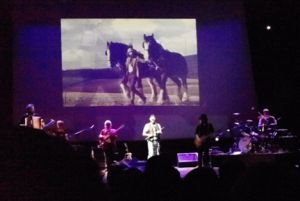
Leave it to Ian Anderson to prove the naysayers wrong and make the “Thick as a Brick II” [TAAB II] tour the must-see prog rock concert this year. Strip away some of what Anderson himself calls the school boy humor woven within the lyrics and other material in the just-released album and the actions in the accompanying stage show – that is as much theatre as it is music – and you’ll find a poignant reflection on a life well lived – or is it?
Those that gripe about Anderson’s choice of players on this tour – he has at least temporarily forsaken lead guitarist extraordinaire Martin Barre, master drummer Doane Perry, and the rest of the much loved modern-day Jethro Tull line up– need only listen to the new music to understand his reasoning.
But first some background — Anderson wrote the original “Thick as a Brick,” [TAAB] which was released in 1972, as something of a personal meditation about civility, art, love, war, and religion. He cloaked the messages in a modern-day “Spinal Tap” treatment weaving his introspections around the fictional Gerald (Little Milton) Bostock who at age 8 wrote an “epic poem” titled “Thick as a Brick” that initially won him first place in a prestigious literary contest. Yet when the poem was read on the BBC, hundreds of “protests and threats” followed and Bostock was disqualified from the competition and presumably shamed.
“Thick as a Brick II” is a salute to Bostock and a look at what became of the young wunderkind some 40 years after that and other scandals befell him. Of course, the magic is that Bostock is Anderson’s alter ego thus giving us insight into the prog rock genius’ own musings about his life and, naturally, his life’s work.
All sounds a bit, well, heavy, doesn’t it? It’s not at all, further underscoring the arguable genius of Anderson. Who else could so deftly weave video – beginning with his own portrayal of the apparently renowned psychiatrist Dr. Max Quad who is charged with treating the now adult Bostock – still photos of everything from a scuba diver stomping about an urban area searching for water (check out “Aqualung” for the explanation) to Anderson himself in various locales throughout the years– in a manner that keeps an audience rapt but never lets style topple substance?
Anderson’s presentation may seem somewhat grand verging on pretentious to some – especially hard rock fans in a particular audience that continually expressed dismay about the theatrical elements of the show– but peek beneath the surface and you’ll see it actually represents Anderson at his most humble.
This is a man who understands that his voice often sounds every bit of its 64 years, that while he can stand on one leg as befits the beloved “Minstrel in the Gallery,” extended poses of that sort are truly a young man’s game. Beyond that, of course, are his own reflections on spending his life as a musician instead of pursuing other personal passions such as politics, environmental causes or even literature.
So what does Anderson do to convey the myriad choices he and others have and may make? Enter Ryan O’Donnell, an actor/musician who not only shared lead vocals with Anderson on some of the most heartfelt lyrics on both TAAB and TAABII but acted out the stage antics that required a somewhat spry physique.
Let’s be honest – those that love the modern classic Tull line up (diehard fans will know what that means) don’t want to admit that the players Anderson chose for this solo project — guitarist Florian Opahle, bassist David Goodier, drummer Scott Hammond and keyboardist John O’Hara — are musical virtuosos. Clearly, they are as evidenced by their masterful interpretation of the intricate music of TAAB and TAABII and the additional flourishes including solos with nods to the audience.
And that leads us back to just why Anderson – who did everything from write the music to design the sets and choose the lighting for the concerts – also chose to make TAABII a solo project.
When he and Jethro Tull first toured with TAAB in the 1970s, he was incensed by audiences’ insensitivity to the fine points of the lyrics and music. Instead of mulling the insights Anderson wove into the work, fans glommed onto the hard rock elements of the songs and the performances.
Anderson basically responded by shelving TAAB and giving the audiences what they wanted from Jethro Tull concerts in the form of hard rock versions of “Aqualung,” “Cross-Eyed Mary,” “Locomotive Breathe,” and other Tull classics, even when wound into sets of his, and Tull’s, more reflective music.
Yet once the Minstrel in the Gallery was persuaded to revisit the story of Bostock and the album that changed prog-rock, the work arguably took on a more personal meaning than perhaps even Anderson imagined it might. Thus, we have Bostock/Anderson as a younger man in the form of O’Donnell, and as himself, after his 64-year journey.
In his decades as a musician, songwriter, and producer, Anderson has sought to give his fans the music and musings they sought. At last, he’s shared what the expedition has meant to him, cloaked in his trademark, waggish form.


No Comments comments associated with this post